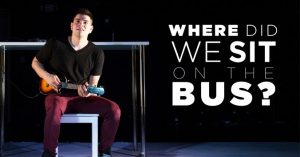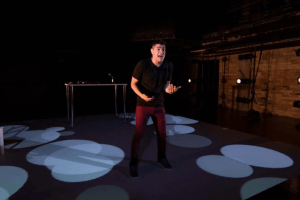
March 3, 2021
 [rating=4]Bursting with comedy, wit, and thoughtful self-examination, Brian Quijada’s 90-minute autobiographical show is a one-man marvel! It’s impressive how Quijada holds our attention throughout as he rotates his monologue from his own perspective to that of his father and his mother. Quijada (which means “jaw” in Spanish) takes us on his quest to become “the best performer he could be” and finds himself thrilling audiences on stage at his March 2016 world-premiere show at the Victory Gardens Theater, in Chicago. Exactly five years later, the 2021 resurrection of this live event works perfectly for remote viewing on Vimeo as a collaboration between the Victory Gardens, Bitter Jester Studios, and the Geva Theatre Center, all of which have produced this show as part of their 2020-2021 offerings.
[rating=4]Bursting with comedy, wit, and thoughtful self-examination, Brian Quijada’s 90-minute autobiographical show is a one-man marvel! It’s impressive how Quijada holds our attention throughout as he rotates his monologue from his own perspective to that of his father and his mother. Quijada (which means “jaw” in Spanish) takes us on his quest to become “the best performer he could be” and finds himself thrilling audiences on stage at his March 2016 world-premiere show at the Victory Gardens Theater, in Chicago. Exactly five years later, the 2021 resurrection of this live event works perfectly for remote viewing on Vimeo as a collaboration between the Victory Gardens, Bitter Jester Studios, and the Geva Theatre Center, all of which have produced this show as part of their 2020-2021 offerings.
It’s amazing to see how well the multitalented and versatile Quijada can write, act, sing, dance, and play the harmonica and (what appears to be) a tenor ukulele. He is a master in how he handles his own sound effects. His meaty script combines original music and lyrics—largely rap plus some ingenious prose and poetry—plus all sorts of humor. Yet there is a lot thrown at the audience at once. It is an education and tough to absorb in one sitting.
Quijada and his next older brother were born in this country, while his parents and two oldest brothers were born in El Salvador. His family came to the United States to create a better life for themselves, and his parents had high hopes for their son to become a success in mainstream white society, such as becoming a doctor or lawyer. But Quijada had other ideas about what to do with his life. Throughout his narrative, we learn about his journey to achieve his personal dream of becoming a performing artist and also what he had to undergo to be accepted by others. What is life in America like for a brown person of Hispanic descent? We watch Quijada rise above being the victim of racial and ethnic discrimination to gain a fuller understanding of his existence at this point in time. He doesn’t only identify with the culture of his birth or even that of mainstream American culture but is in the enviable position of being able to internalize both the immigrant experience and the multiculturalism of the various ethnic groups that make up this country.
The title “Where Did We Sit on the Bus?” is a reference to the Civil Rights Movement and how Hispanics don’t seem to make it onto the proverbial bus. He explains that while he was in elementary school, he learned the history of white America from his textbooks and of black America in stories about heroes such as Rosa Parks, who started the Montgomery bus boycott. But Quijada says that he learned nothing in school about Hispanic Americans and their origins and how hard they have struggled to get to this country to achieve a better life and the American Dream. Hence the politics of the day finds itself into the storyline, and he refers to the many young “dreamers” who came to this country without documentation. Why not let them stay? “Is it wrong to have an obsession with wanting a happier life and having… your dream?”
Yet this is very much a Chicago story. Quijada talks about living in Glenview and then further north in Highwood, Illinois. He discusses how he had brown friends from the “old neighborhood” as well as those who were white and Jewish from neighboring Highland Park during the years he was in high school. And yet Quijada could have been of any race or ethnicity or skin color living in the United States. Life is full of stories of “misfits” and dreamers (however defined) who will not be deterred from accomplishing their goals, whatever they may be.
Credit for this production must be two-fold: first for the original stage presentation and secondly for the recorded video. The original tech crew at the Victory Gardens Theater—Stage Set Designer Chay Yew, Stage Lighting Designer Diane L. Fairchild, and Stage Projection Designer Liviu Pasare—all believed in minimalist staging. This allows the video producers to concentrate intently on Quijada rather than on some elaborate setting, making the show look as if it could have been devised as a video in the first place. Video Director and Editor Nicolas DeGrazia and Director of Photography Daniel Kullman (both of whom also serve as camera operators plus Tabbi Koller and Jason Krayneck) have done a marvelous job with their terrific camera design (including closeups) and polished editing.
Growth can be painful, and every generation has its struggles… and its dreams. “What my father considered a luxury, I considered a necessity,” Quijada says at one point during the performance. He was referring to his need for art in his life. However, the same idea could just as well apply to the need for material goods. Who in this country today would ever imagine walking to and from school with no shoes? His father didn’t get his first pair in El Salvador until he was eighteen years old.
“I’m asking huge questions to understand life,” says Quijada. In so doing, he believes he has finally found himself through creative expression and tells us, “I’m the best version of myself when I’m happy creating my art.”
“Where Did We Sit on the Bus?” is playing online on Vimeo on Demand through March 7, 2021. The show can be streamed on TV, mobile, tablet, and computer.
Tickets are $30 each. To purchase tickets, please go to: tickets@victorygardens.org or call the Box Office at 773-871-3000.
For more information on this and other shows being offered by the Victory Gardens Theater, please go to https://victorygardens.org/.
Victory Gardens is a not-for-profit organization. Your support at any level contributes to the ongoing success of its many productions and programs. Please consider making a donation at this crucial time in Chicago theatre history. Go to: https://victorygardens.org/ways-to-give/.
To see what others are saying ( in addition to previous reviews below) visit www.theatreinchicago.com, go to Review Round-Up and click at “Where Did We Sit On The Bus”.
PREVIOUS REVIEWS reviewed by Lawrence Riordan——————————————————————————————————————————————————————————————————
In Teatro Vista’s one man play, “Where Did We Sit on the Bus,” writer and performer Brian Quijada covers a broad array of issues about the Latino-American experience through his own biography: mixed marriages and their progeny, contemporary political xenophobia, the experience of immigrants, and growing up as a second generation American, and American-Latino American’s identity, especially in the context of our shared historical narrative regarding the civil rights movement and racial progress.
 The play is almost entirely the work of Brian Quijada, who wrote the script, obviously based on his own life, performs in the play, and did the sound design-much of which consists of him speaking or in something between a Bobby Kennedy like staccato and rap music, albeit of the high-brow, meaningful variety, and I enjoyed every minute of the performance even though I generally find rap entirely, of whatever kind, entirely unpalatable.
The play is almost entirely the work of Brian Quijada, who wrote the script, obviously based on his own life, performs in the play, and did the sound design-much of which consists of him speaking or in something between a Bobby Kennedy like staccato and rap music, albeit of the high-brow, meaningful variety, and I enjoyed every minute of the performance even though I generally find rap entirely, of whatever kind, entirely unpalatable.
While most of the play traces Quijada’s biography from his time in the womb through his strange education in elementary school; his friendship with affluent white student’s in middle school; and as he grows older his constant conflict with his Dad over his desire to be a professional musician rather than a bilingual doctor or lawyer; his time in college, his first performances; his engagement; and his honeymoon, some of the most moving stories land comical where the one’s told by other characcters who Quijada inhabits well, particularly the heart rending story of his father’s flight from El Salvador, perhaps even better than in the narration of his own story which is in itself extremely impressive.
Director Chay directs Quijada well, moving him effectively round the stage, and clearly was able to work in conjunction with the actor to bring the various settings off his play, (an apartment, a beach, a classroom, his house, a school cafeteria, and a posh Jewish home to life) all with very minimal props. In addition, Diane A. Fairechild providing some intense lighting that, like Quijata’s American identity is hard to define, it was neither disco, nor strobe, but intense and flashing with dots as you might find on a dance floor, but more theatrical and less practical (I doubt it could actually be used on a dance floor). 90 minutes, no intermission,
” Where Did We Sit on the Bus? “is showing at the storefront theatre, located at 66 East Randolph Street (between Michigan Avenue and Wabash) through April 10th 2016, located at Randolph Street Chicago. Performances are :
Thursday’s through Saturdays at 7:30
Sunday’s at 3:pm.
Regular Tickets are $15. Tickets for Students and Seniors (65+) are $12 with a valid ID. They can be purchased at all HotTix locations or by visiting teatrovista.org. More information about the play can be found at www.teatrovista.org
To see what others are saying, visit www.theatreinchicago.com, go to Review Round-Up and click at “Where Did We Sit On the Bus?”
—————————————————————————————————————————————————————————————————————
The Civil Rights movement is as important today as it was back in the 1960’s. The title of one of the “Up Close & Personal” series of plays, now on the stage at Victory Gardens, deals in a unique and different way with this subject. As we all were taught, during the days of yore, there were “Whites Only” and “Negroes Only” drinking fountains, public bathrooms and more. But what about the Asian and Hispanics? Where were they to go? “Where Did We Sit On The Bus”, written and performed by the amazingly talented Brian Quijada, under the skillful eye of director Chay Chew, tells us the story of a young Latino, who before getting married to a very “white” young lady, asks the question- “What do I tell our children? “Where did we sit on the bus”? A question that arose in his life, back in the third grade.
Quijada is powerful as an actor. He also plays the electric ukulele, harmonica and is able to work with the sounds of a DJ/rapper so he can tell us HIS story through what he has learned to live with and through. Brian grew up right here in the “greater Chicago” area, having resided in the Sunset Park “trailer homes (some people call them “manufactured homes”) in Glenview and then moving to an actual home in Highwood. Both of these communities were heavily composed of Hispanics, so in his early years, he was exposed to his own heritage, but since both areas were highly integrated, he was also exposed to the “white” lives that were different from his, and his family’s.
During the 90 minutes of story-telling (a beautiful job worthy of every and any award to be given for this type of show), Brian examines what his life was like in both areas where he grew up. His desire to enter the “theater”, which was not something his parents were pleased about, allowed him to reach even further into the other cultures around him. Living in Highwood, a very close community to Highland Park, allowed him to cross cultural lines and form friendships with the Jewish, far more affluent kids. He learned from them and was able to open his eyes to the “other world” around him.
Going into the arts was not as easy for him as for others. His parents were here for better education for their children. To watch their children have better educations, earn more and be financially stable- that is why they fought their way out of Mexico , making one sacrifice after another to come to the United States. As Brian notes, being a performing artist was “not in the cards”. Yet, this was the life and career path that was chosen for him. Based on how he tells the story, one might say, the career path was chosen for him (by a power far greater than his own choice). From an audience member’s viewpoint, I would have to say, that is correct. He belongs on the stage, telling us his stories, playing us his music, dancing and doing all the things he does so well. He is a treat to watch and deserves the previous Jeff Awards he received.
In his story, we learn about his early stages, his parents, his friends and what takes place in his life. The events that change the course of Brian Quijada’s life! They are comical, they are musical, they are heartwarming, but most of all , they  are real! There are many times I base my review’s ratings on Jane’s reaction to a play. She loved this one! Jane was into everything and each detail of Brian’s story and remarked at the conclusion that he was “very talented”! She is correct. he is! The story ends with a close look at our present condition and how despite all the supposed progress America has made over the years, we are still not living up to the words (and promise) that is on the plaque of the Statue of Liberty at Ellis Island. Check it out! It will make you think!
are real! There are many times I base my review’s ratings on Jane’s reaction to a play. She loved this one! Jane was into everything and each detail of Brian’s story and remarked at the conclusion that he was “very talented”! She is correct. he is! The story ends with a close look at our present condition and how despite all the supposed progress America has made over the years, we are still not living up to the words (and promise) that is on the plaque of the Statue of Liberty at Ellis Island. Check it out! It will make you think!
While most of what we see and hear is Brian and the direction by Yew, it is of great import to give kudos to the lighting by Diane D. Fairchild. There is no set, just a table with instruments and electronic devices, so the special lighting and the projections (Liviu Pasare) along with the stage management by Amanda J, Davis, make the 90 minute entertainment very special indeed. As stated earlier, this production is part of a special series “Up Close & Personal” which will continue at Victory Gardens, upstairs (Richard Christiansen Theater) thru June 4th running in rep with “A Little Bit Not Normal (Arlene Malinowski) and “St. Jude” (Luis Alfaro).
performances for this show are:
 May 10th, 12th and 19th at 10:00 a.m.
May 10th, 12th and 19th at 10:00 a.m.
May 20th, June 2nd and 3rd at 3 p.m.
May 11th, 13th, 24th, 26th, 28th, 31st and June 4th at 7:30 p.m.
Tickets are $20 each (open seating) with a special $40 package for all 3 shoes and can be purchased at the box office located at 2433 N. Lincoln Avenue, by calling 773-871-3000 or online at www.VictoryGardens.org
For every ticket purchased, Victory Gardens will donate a ticket to a Chicago Public School student allowing them the opportunity to experience “Live theater”- a positive for all concerned.
To see what others are saying, visit www.theatreinchicago.com, go to Review Round-Up and click at “Where Did We Sit On The Bus?”

 REVIEWED by AL BRESLOFF
REVIEWED by AL BRESLOFF




More Stories
“Dummy in Diaspora”
“The Magic School Bus: Lost in the Solar System”
“February House” reviewed by Julia W. Rath